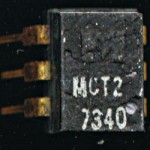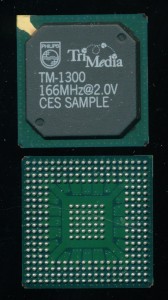December 20th, 2014 ~ by admin

Monsanto MCT2 – LED Based Opto-coupler
This little chip, dated from 1973, is part of the history of what we are surrounded by, LEDs. And they have an unlikely and somewhat surprising beginning. The MCT2 is an opto-coupler, basically an LED and a phototransistor in a single package, used for isolating digital signals. The important portion here is the LED. LEDs are in nearly every electronic product these days, and this Christmas season we see many Christmas lights that are now LED based. THey are more efficient, and much longer lasting. Certainly the eco-friendly choice for lighting. And they have their roots in a company that does not always elicit an eco-friendly discussion.
That would be Monsanto.
That big ‘M’ on the package is for Monsanto, who from 1968-1979 was the leading supplier of LEDs and opto-electronics. In 1968 there were exactly 2 companies who made visible light LEDs (red), HP and Monsanto, and HP used materials supplied by Monsanto to make theirs.

Read More »
December 13th, 2014 ~ by admin

TiMedia TM-1300 – Marketing Sample
The roots of TriMedia start in 1987 at Philips with Gerrit Slavenburg (who wrote actual forwards for most of the Datasheets) and Junien Labrousse as the LIFE-1 processor. At its heart it was a 32-bit VLIW (Very Long Instruction Word) processor. VLIW was a rather new concept in the 1980’s, and really didn’t catch on until the late 90’s. Intel’s i860 could run in superscalar, or VLIW mode in 1989 but ended up a bit of a flop. TI made the C6000 lince of the TMS320 DSP which was VLIW based. By far thos most famous, or perhaps infamous, VLIW implementation were the Transmeta, and the Itanium, both of which proved to be less then successful in the long run (though both ended up finding niche markets).
TriMedia, released their first commercial VLIW product in 1997, the TM1000. As the name suggests, TriMedia Processors are media focused. They are based around a general purpose VLIW CPU core, but add audio, video and graphics processing. THe core is decidedly not designed as a standalone processor. It implements most CPU functions but not all, for example, it supports only 32-bit floating point math (rather than full 64 or 80 bit).
The TM-1300 was released in 1999 and featured a clock speed of 166MHz @ 2.0V on a 0.25u process. At 166MHz the TM-1300 consumed about 3.5W, which at the time was relatively low. It had 32K of Instruction Cache and 16K of Data Cache. As is typical of RISC processors the 1300 had 128 general purpose 32-bit registers. The VLIW instruction length allows five simultaneous operations to be issued every clock cycle. These operations can target any five of the 27 functional units in the processor, including integer and floating-point arithmetic units and SIMD units.
The above picture TM-1300 was a marketing sample handed out to the media during the Consumer Electronics Show for the processors release in 1999. It is marked with the base specs of the chip as well as CES SAMPLE. Likely these were pre-production units that didn’t meet spec or failed inspection, remarked for media give-aways.
Read More »
December 8th, 2014 ~ by admin

DEC 608B 19-14682-00 VAX750 ALP – 4- bit slice
In the mid-1970’s DEC saw the need for a 32-bit successor to the very popular PDP-11. They developed the VAX (Virtual Address eXtension) as its replacement. Its important to realize that VAX was an architecture first, and not designed from the beginning with a particular technological implementation in mind. This varies considerably from the x86 architecture which initially was designed for the 8086 processor, with its specific technology (NMOS, 40 DIP, etc) in mind. VAX was and is implemented (or emulated as DEC often called it) in many ways, on many technologies. The architecture was largely designed to be programmer centric, writing software for VAX was mean to be rather independent of what it ran on (very much like what x86 has become today).
The first implementation was the VAX 11/780 Star, released in 1977, which was implemented in TTL, and clocked at 5MHz. TTL allowed for higher performance, but at the expense of greater board real estate as well as somewhat less reliability (more IC’s means more failure points). It also cost more, to purchase, to run, and to cool.
DEC followed the Star with the 11/750 Comet in 1980. This was a value version of the Star. It ran at only 3.12MHz (320ns cycle time) but introduced some new technology. Part of the ‘value’ was a much smaller footprint. The TTL had been replaced by bi-polar gate arrays. Over 90% of the VAX architecture was implemented in the gate arrays, and there was a lot of them, 95 in a complete system with the floating point accelerator (28 arrays). The CPU and Memory controller used 55 while the Massbus (I/O) used an additional 12 gate arrays. The 95 gate arrays though replaced hundreds of discrete TTL chips. And as a further simplification they were all the same gate array.
Read More »





